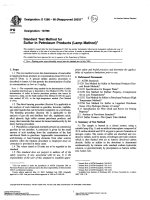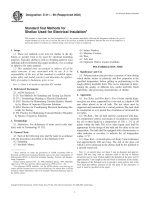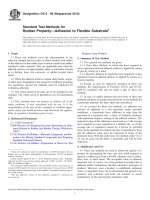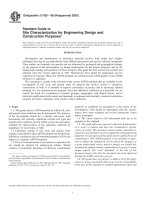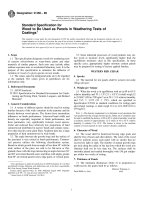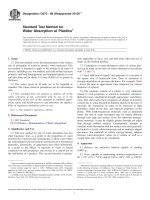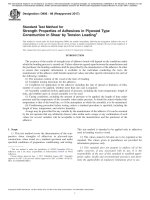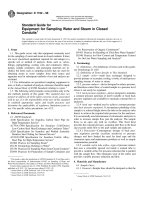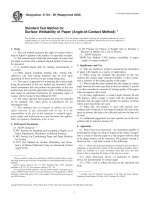Astm d 420 98 (2003)
Bạn đang xem bản rút gọn của tài liệu. Xem và tải ngay bản đầy đủ của tài liệu tại đây (60.31 KB, 7 trang )
Designation: D 420 – 98 (Reapproved 2003)
Standard Guide to
Site Characterization for Engineering Design and
Construction Purposes1
This standard is issued under the fixed designation D 420; the number immediately following the designation indicates the year of
original adoption or, in the case of revision, the year of last revision. A number in parentheses indicates the year of last reapproval. A
superscript epsilon (e) indicates an editorial change since the last revision or reapproval.
INTRODUCTION
Investigation and identification of subsurface materials involves both simple and complex
techniques that may be accomplished by many different procedures and may be variously interpreted.
These studies are frequently site specific and are influenced by geological and geographical settings,
by the purpose of the investigation, by design requirements for the project proposed, and by the
background, training, and experience of the investigator. This guide has been extensively rewritten and
enlarged since the version approved in 1987. Material has been added for clarification and for
expansion of concepts. Many new ASTM standards are referenced and a bibliography of non-ASTM
references is appended.
This document is a guide to the selection of the various ASTM standards that are available for the
investigation of soil, rock, and ground water for projects that involve surface or subsurface
construction, or both. It is intended to improve consistency of practice and to encourage rational
planning of a site characterization program. Since the subsurface conditions at a particular site are
usually the result of a combination of natural, geologic, topographic, and climatic factors, and of
historical modifications both natural and manmade, an adequate and internally consistent exploration
program will allow evaluation of the results of these influences.
materials or conditions be encountered in the course of the
investigation, work should be interrupted until the circumstances have been evaluated and revised instructions issued
before resumption.
1.4 The values stated in (SI) inch-pound units are to be
regarded as the standard.
1.5 This guide offers an organized collection of information
or a series of options and does not recommend a specific
course of action. This document cannot replace education or
experience and should be used in conjunction with professional
judgment. Not all aspects of this guide may be applicable in all
circumstances. This ASTM standard is not intended to represent or replace the standard of care by which the adequacy of
a given professional service must be judged, nor should this
document be applied without consideration of a project’s many
unique aspects. The word“ Standard” in the title of this
document means only that the document has been approved
through the ASTM consensus process.
1.6 This guide does not purport to address all of the safety
concerns, if any, associated with its use. It is the responsibility
of the user of this standard to establish appropriate safety and
1. Scope
1.1 This guide refers to ASTM methods by which soil, rock,
and ground water conditions may be determined. The objective
of the investigation should be to identify and locate, both
horizontally and vertically, significant soil and rock types and
ground water conditions present within a given site area and to
establish the characteristics of the subsurface materials by
sampling or in situ testing, or both.
1.2 Laboratory testing of soil, rock, and ground water
samples is specified by other ASTM standards not listed herein.
Subsurface exploration for environmental purposes will be the
subject of a separate ASTM document.
1.3 Prior to commencement of any intrusive exploration the
site should be checked for underground utilities. Should
evidence of potentially hazardous or otherwise contaminated
1
This guide is under the jurisdiction of ASTM Committee D18 on Soil and Rock
and is the direct responsibility of Subcommittee D18.01 on Surface and Subsurface
Characterization.
Current edition approved March 10, 1998. Published January 1999. Originally
published as D 425 – 65 T. Last previous edition D 420 – 93.
Copyright © ASTM International, 100 Barr Harbor Drive, PO Box C700, West Conshohocken, PA 19428-2959, United States.
1
D 420 – 98 (2003)
D 4220 Practices for Preserving and Transporting Soil
Samples
D 4394 Test Method for Determining the In Situ Modulus
of Deformation of Rock Mass Using the Rigid Plate
Loading Method
D 4395 Test Method for Determining the In Situ Modulus
of Deformation of Rock Mass Using the Flexible Plate
Loading Method
D 4403 Practice for Extensometers Used in Rock
D 4428 Test Methods for Crosshole Seismic Testing
D 4429 Test Method for CBR (California Bearing Ratio) of
Soils in Place
D 4452 Methods for X-Ray Radiography of Soil Samples
D 4506 Test Method for Determining the In Situ Modulus
of Deformation of Rock Mass Using a Radial Jacking Test
D 4544 Practice for Estimating Peat Deposit Thickness
D 4553 Test Method for Determining the In Situ Creep
Characteristics of Rock
D 4554 Test Method for In Situ Determination of Direct
Shear Strength of Rock Discontinuities
D 4555 Test Method for Determining Deformability and
Strength of Weak Rock by an In Situ Uniaxial Compressive Test
D 4622 Test Method for Rock Mass Monitoring Using
Inclinometers
D 4623 Test Method for Determination of In Situ Stress in
Rock Mass by Overcoring Method—USBM Borehole
Deformation Gage
D 4630 Test Method for Determining Transmissivity and
Storativity of Low Permeability Rocks by In Situ Measurements Using the Constant Head Injection Test
D 4631 Test Method for Determining Transmissivity and
Storativity of Low Permeability Rocks by In Situ Measurements Using the Pressure Pulse Technique
D 4633 Test Method for Stress Wave Energy Measurement
for Dynamic Penetrometer Testing Systems
D 4645 Test Method for Determination of the In Situ Stress
in Rock Using the Hydraulic Fracturing Method
D 4700 Guide for Soil Sampling from the Vadose Zone
D 4719 Test Method for Pressuremeter Testing in Soils
D 4729 Test Method for In Situ Stress and Modulus of
Deformation Using the Flatjack Method
D 4750 Test Method for Determining Subsurface Liquid
Levels in a Borehole or Monitoring Well (Observation
Well)
D 4879 Guide for Geotechnical Mapping of Large Underground Openings in Rock
D 4971 Test Method for Determining the In Situ Modulus
of Deformation of Rock Using the Diametrically Loaded
76-mm (3-in.) Borehole Jack
D 5079 Practices for Preserving and Transporting Rock
Core Samples
D 5088 Practice for Decontamination of Field Equipment
Used at Nonradioactive Waste Sites
D 5092 Practice for Design and Installation of Ground
Water Monitoring Wells in Aquifers
health practices and determine the applicability of regulatory
limitations prior to use.
2. Referenced Documents
2.1 ASTM Standards: 2
C 119 Terminology Relating to Dimension Stone
C 294 Descriptive Nomenclature for Constituents of Natural Mineral Aggregates
C 851 Practice for Estimating Scratch Hardness of Coarse
Aggregate Particles
D 75 Practice for Sampling Aggregates
D 653 Terminology Relating to Soil, Rock, and Contained
Fluids
D 1194 Test Method for Bearing Capacity of Soil for Static
Load and Spread Footings
D 1195 Test Method for Repetitive Static Plate Load Tests
of Soils and Flexible Pavement Components, for Use in
Evaluation and Design of Airport and Highway Pavements
D 1196 Test Method for Nonrepetitive Static Plate Load
Tests of Soils and Flexible Pavement Components, for Use
in Evaluation and Design of Airport and Highway Pavements
D 1452 Practice for Soil Investigation and Sampling by
Auger Borings
D 1586 Test Method for Penetration Test and Split-Barrel
Sampling of Soils
D 1587 Practice for Thin-Walled Tube Sampling of Soils
D 2113 Practice for Rock Core Drilling, and Sampling of
Rock for Site Investigation
D 2487 Classification of Soils for Engineering Purposes
(Unified Soil Classification System)
D 2488 Practice for Description and Identification of Soils
(Visual-Manual Procedure)
D 2573 Test Method for Field Vane Shear Test in Cohesive
Soil
D 2607 Classification of Peats, Mosses, Humus, and Related Products
D 3017 Test Method for Water Content of Soil and Rock in
Place by Nuclear Methods (Shallow Depth)
D 3213 Practices for Handling, Storing, and Preparing Soft
Undisturbed Marine Soil
D 3282 Classification of Soils and Soil-Aggregate Mixtures
for Highway Construction Purposes
D 3385 Test Method for Infiltration Rate of Soils in Field
Using Double-Ring Infiltrometers
D 3404 Guide to Measuring Matric Potential in the Vadose
Zone Using Tensiometers
D 3441 Test Method for Deep, Quasi-Static, Cone and
Friction-Cone Penetration Tests of Soil
D 3550 Practice for Ring-lined Barrel Sampling of Soils
D 3584 Practice for Indexing Papers and Reports on Soil
and Rock for Engineering Purposes
D 4083 Practice for Description of Frozen Soils (VisualManual Procedure)
2
For referenced ASTM standards, visit the ASTM website, www.astm.org, or
contact ASTM Customer Service at For Annual Book of ASTM
Standards volume information, refer to the standard’s Document Summary page on
the ASTM website.
2
D 420 – 98 (2003)
D 5093 Test Method for Field Measurement of Infiltration
Rate Using a Double-Ring Infiltrometer with a SealedInner Ring
D 5126 Guide for Comparison of Field Methods for Determining Hydraulic Conductivity in the Vadose Zone
D 5195 Test Method for Density of Soil and Rock In-Place
at Depths Below the Surface by Nuclear Methods
E 177 Practice for the Use of the Terms Precision and Bias
in ASTM Test Methods
E 380 Practice for the Use of the International System of
Units (SI) (the Modernized Metric System)
G 51 Test Method for pH of Soil for Use in Corrosion
Testing
G 57 Method for Field Measurement of Soil Resistivity
Using the Wenner Four-Electrode Method
NOTE 1—While certain of the older maps and reports may be obsolete
and of limited value in the light of current knowledge, a comparison of the
old with the new will often reveal valuable information.
4.1.1 The United States Geological Survey and the geological surveys of the various states are the principal sources of
geologic maps and reports on mineral resources and ground
water.
4.1.2 United States Department of Agriculture Soil Conservation Service soil surveys, where available and of recent date,
should enable the investigator to estimate the range in soil
profile characteristics to depths of 5 or 6 ft (1.5 or 2 m) for each
soil mapped.
NOTE 2—Each soil type has a distinctive soil profile due to age, parent
material, relief, climatic condition, and biological activity. Consideration
of these factors can assist in identifying the various soil types, each
requiring special engineering considerations and treatment. Similar engineering soil properties are often found where similar soil profiles
characteristics exist. Changes in soil properties in adjacent areas often
indicate changes in parent material or relief.
3. Significance and Use
3.1 An adequate soil, rock, and ground water investigation
will provide pertinent information for decision making on one
or more of the following subjects:
3.1.1 Optimum location of the structure, both vertically and
horizontally, within the area of the proposed construction.
3.1.2 Location and preliminary evaluation of suitable borrow and other local sources of construction aggregates.
3.1.3 Need for special excavating and dewatering techniques with the corresponding need for information, even if
only approximate, on the distribution of soil water content or
pore pressure, or both, and on the piezometric heads and
apparent permeability (hydraulic conductivity) of the various
subsurface strata.
3.1.4 Investigation of slope stability in natural slopes, cuts,
and embankments.
3.1.5 Conceptual selection of embankment types and hydraulic barrier requirements.
3.1.6 Conceptual selection of alternate foundation types and
elevations of the corresponding suitable bearing strata.
3.1.7 Development of additional detailed subsurface investigations for specific structures or facilities.
3.2 The investigation may require the collection of sufficiently large soil and rock samples of such quality as to allow
adequate testing to determine the soil or rock classification or
mineralogic type, or both, and the engineering properties
pertinent to the proposed design.
3.3 This guide is not meant to be an inflexible description of
investigation requirements; methods defined by other ASTM
standards or non-ASTM techniques may be appropriate in
some circumstances. The intent is to provide a checklist to
assist in the design of an exploration/investigation plan.
4.2 In areas where descriptive data are limited by insufficient geologic or soil maps, the soil and rock in open cuts in the
vicinity of the proposed project should be studied and various
soil and rock profiles noted. Field notes of such studies should
include data outlined in 10.6.
4.3 Where a preliminary map covering the area of the
project is desired, it can be prepared on maps compiled from
aerial photography that show the ground conditions. The
distribution of the predominant soil and rock deposits likely to
be encountered during the investigation may be shown using
data obtained from geologic maps, landform analysis and
limited ground reconnaissance. Experienced photo-interpreters
can deduce much subsurface data from a study of black and
white, color, and infrared photographs because similar soil or
rock conditions, or both, usually have similar patterns of
appearance in regions of similar climate or vegetation.
NOTE 3—This preliminary map may be expanded into a detailed
engineering map by locating all test holes, pits, and sampling stations and
by revising boundaries as determined from the detailed subsurface survey.
4.4 In areas where documentary information is insufficient,
some knowledge of subsurface conditions may be obtained
from land owners, local well drillers, and representatives of the
local construction industry.
5. Exploration Plan
5.1 Available project design and performance requirements
must be reviewed prior to final development of the exploration
plan. Preliminary exploration should be planned to indicate the
areas of conditions needing further investigation. A complete
soil, rock, and ground water investigation should encompass
the following activities:
5.1.1 Review of available information, both regional and
local, on the geologic history, rock, soil, and ground water
conditions occurring at the proposed location and in the
immediate vicinity of the site.
5.1.2 Interpretation of aerial photography and other remote
sensing data.
4. Reconnaissance of Project Area
4.1 Available technical data from the literature or from
personal communication should be reviewed before any field
program is started. These include, but are not limited to,
topographic maps, aerial photography, satellite imagery, geologic maps, statewide or county soil surveys and mineral
resource surveys, and engineering soil maps covering the
proposed project area. Reports of subsurface investigations of
nearby or adjacent projects should be studied.
3
D 420 – 98 (2003)
rock properties. Satellite and aircraft spectral mapping tools,
such as LANDSAT, may be used to find and map the areal
extent of subsurface materials and geologic structure. Interpretation of aircraft photographs and satellite imagery can locate
and identify significant geologic features that may be indicative
of faults and fractures. Some ground control is generally
required to verify information derived from remote sensing
data.
7.3 Geophysical survey methods may be used to supplement
borehole and outcrop data and to interpolate between holes.
Seismic, ground penetrating radar, and electrical resistivity
methods can be particularly valuable when distinct differences
in the properties of contiguous subsurface materials are indicated.
7.4 Shallow seismic refraction/reflection and ground penetrating radar techniques can be used to map soil horizons and
depth profiles, water tables, and depth to bedrock in many
situations, but depth penetration and resolution vary with local
conditions. Electromagnetic induction, electrical resistivity,
and induced polarization (or complex resistivity) techniques
may be used to map variations in water content, clay horizons,
stratification, and depth to aquifer/bedrock. Other geophysical
techniques such as gravity, magnetic, and shallow ground
temperature methods may be useful under certain specific
conditions. Deep seismic and electrical methods are routinely
used for mapping stratigraphy and structure of rock in conjunction with logs. Crosshole shear wave velocity measurements can provide soil and rock parameters for dynamic
analyses.
7.4.1 The seismic refraction method may be especially
useful in determining depth to, or rippability of, rock in
locations where successively denser strata are encountered.
7.4.2 The seismic reflection method may be useful in
delineating geological units at depths below 10 ft (3 m). It is
not constrained by layers of low seismic velocity and is
especially useful in areas of rapid stratigraphic change.
7.4.3 The electrical resistivity method, Method G 57, may
be similarly useful in determining depth to rock and anomalies
in the stratigraphic profile, in evaluating stratified formations
where a denser stratum overlies a less dense stratum, and in
location of prospective sand-gravel or other sources of borrow
material. Resistivity parameters also are required for the design
of grounding systems and cathodic protection for buried
structures.
7.4.4 The ground penetrating radar method may be useful in
defining soil and rock layers and manmade structures in the
depth range of 1 to 30 ft (1⁄3 to 10 m).
5.1.3 Field reconnaissance for identification of surficial
geologic conditions, mapping of stratigraphic exposures and
outcrops, and examination of the performance of existing
structures.
5.1.4 On site investigation of the surface and subsurface
materials by geophysical surveys, borings, or test pits.
5.1.5 Recovery of representative disturbed samples for
laboratory classification tests of soil, rock, and local construction material. These should be supplemented by undisturbed
specimens suitable for the determination of those engineering
properties pertinent to the investigation.
5.1.6 Identification of the position of the ground water table,
or water tables, if there is perched ground water, or of the
piezometric surfaces if there is artesian ground water. The
variability of these positions in both short and long time frames
should be considered. Color mottling of the soil strata may be
indicative of long-term seasonal high ground water positions.
5.1.7 Identification and assessment of the location of suitable foundation material, either bedrock or satisfactory loadbearing soils.
5.1.8 Field identification of soil sediments, and rock, with
particular reference to type and degree of decomposition (for
example, saprolite, karst, decomposing or slaking shales), the
depths of their occurrence and the types and locations of their
structural discontinuities.
5.1.9 Evaluation of the performance of existing installations, relative to their structure foundation material and environment in the immediate vicinity of the proposed site.
6. Equipment and Procedures for Use in Exploration
6.1 Pertinent ASTM Standards—Practices D 1452, D 2113,
D 4544, D 5088, D 5092; Method D 1586; and Test Methods
D 4622, D 4633, D 4750.
6.2 The type of equipment required for a subsurface investigation depends upon various factors, including the type of
subsurface material, depth of exploration, the nature of the
terrain, and the intended use of the data.
6.2.1 Hand Augers, Hole Diggers, Shovels, and Push Tube
Samplers are suitable for exploration of surficial soils to
depths of 3 to 15 ft (1 to 5 m).
6.2.2 Earth Excavation Equipment, such as backhoes, draglines, and drilled pier augers (screw or bucket) can allow in
situ examination of soil deposits and sampling of materials
containing very large particles. The investigator should be
aware of the possiblity of permanent disturbance of potential
bearing strata by unbalanced pore pressure in test excavations.
6.2.3 Soil and rock boring and drilling machines and proofing devices may be used to depths of 200 to 300 ft in soil and
to a much greater depth in rock.
6.2.4 Well drilling equipment may be suitable for deep
geologic exploration. Normally samples are in the form of
sand-sized cuttings captured from the return flow, but coring
devices are available.
NOTE 4—Surface geophysical investigations can be a useful guide in
determining boring or test hole locations. If at all possible, the interpretation of geophysical studies should be verified by borings or test
excavations.
8. Sampling
7. Geophysical Exploration
7.1 Pertinent ASTM Standards—Test Methods D 4428 and
Method G 57.
7.2 Remote sensing techniques may assist in mapping the
geological formations and for evaluating variations in soil and
8.1 Pertinent ASTM Standards—Practices D 75, D 1452,
D 1587, D 2113, D 3213, D 3550, D 4220, D 5079; Test
Method D 1586; Methods D 4452; and Guide D 4700.
8.2 Obtain samples that adequately represent each subsurface material that is significant to the project design and
4
D 420 – 98 (2003)
construction. The size and type of sample required is dependent upon the tests to be performed, the relative amount of
coarse particles present, and the limitations of the test equipment to be used.
10. Determination of Subsurface Conditions
10.1 Subsurface conditions are positively defined only at the
individual test pit, hole, boring, or open cut examined. Conditions between observation points may be significantly different
from those encountered in the exploration. A stratigraphic
profile can be developed by detailed investigations only where
determinations of a continuous relationship of the depths and
locations of various types of soil and rock can be inferred. This
phase of the investigation may be implemented by plotting logs
of soil and rock exposures in walls of excavations or cut areas
and by plotting logs of the test borings. Then one may
interpolate between, and extrapolate a reasonable distance
beyond, these logs. The spacing of these investigations should
depend on the geologic complexity of the project area and on
the importance of soil and rock continuity to the project design.
Exploration should be deep enough to identify all strata that
might be significantly affected by the proposed use of the site
and to develop the engineering data required to allow analysis
of the items listed in Section 4 for each project.
NOTE 5—The size of disturbed or bulk samples for routine tests may
vary at the discretion of the geotechnical investigator, but the following
quantities are suggested as suitable for most materials: (a) Visual
classification—50 to 500 g (2 oz to 1 lb); ( b) Soil constants and particle
size analysis of non-gravelly soil—500 g to 2.5 kg (1 to 5 lb); (c) Soil
compaction tests and sieve analysis of gravelly soils—20 to 40 kg (40 to
80 lb); (d) Aggregate manufacture or aggregate properties tests—50 to 200
kg (100 to 400 lb).
8.3 Accurately identify each sample with the boring, test
hole, or testpit number and depth below reference ground
surface from which it was taken. Place a waterproof identification tag inside the container, securely close the container,
protect it to withstand rough handling, and mark it with proper
identification on the outside. Keep samples for natural water
content determination in sealed containers to prevent moisture
loss. When drying of samples may affect classification or
engineering properties test results, protect them to minimize
moisture loss. Practices D 4220 and D 5079 address the transportation of samples from field to laboratory. Most of the titles
of the referenced standards are self-explanatory, but some need
elaboration for the benefit of the users of this guide.
8.3.1 Practice D 75 describes the sampling of coarse and
fine aggregates for the preliminary investigation of a potential
source of supply.
8.3.2 Practice D 1452 describes the use of augers in soil
investigations and sampling where disturbed soil samples can
be used. Depths of auger investigations are limited by ground
water conditions, soil characteristics, and equipment used.
8.3.3 Test Method D 1586 describes a procedure to obtain
representative soil samples for identification and classification
laboratory tests.
8.3.4 Practice D 1587 describes a procedure to recover
relatively undisturbed soil samples suitable for laboratory
testing.
8.3.5 Practice D 2113 describes a procedure to recover
intact samples of rock and certain soils too hard to sample by
Test Method D 1586 or Practice D 1587.
8.3.6 Practice D 3550 describes a procedure for the recovery of moderately disturbed, representative samples of soil for
classification testing and, in some cases, shear or consolidation
testing.
NOTE 6—Plans for a program of intrusive subsurface investigation
should consider possible requirements for permits for installation and
proper closure of bore holes and wells at the completion of the investigation.
10.2 The depth of exploratory borings or test pits for
roadbeds, airport paving, or vehicle parking areas should be to
at least 5 ft (1.5 m) below the proposed subgrade elevation.
Special circumstances may increase this depth. Borings for
structures, excavations, or embankments should extend below
the level of significant stress or ground water influence from
the proposed load as determined by subsurface stress analysis.
10.3 When project construction or performance of the
facility may be affected by either previous water-bearing
materials or impervious materials that can block internal
drainage, borings should extend sufficiently to determine those
engineering and hydrogeologic properties that are relevant to
the project design.
10.4 In all borrow areas the borings or test pits should be
sufficient in number and depth to outline the required quantities
of material meeting the specified quality requirements.
10.5 Where frost penetration or seasonal desiccation may be
significant in the behavior of soil and rock, borings should
extend well below the depth from finished grade of the
anticipated active zone.
10.6 Exploration records shall be kept in a systematic
manner for each project. Such records shall include:
10.6.1 Description of each site or area investigated. Each
test hole, boring, test pit, or geophysical test site shall be
clearly located (horizontally and vertically) with reference to
some established coordinate system, datum, or permanent
monument.
10.6.2 Logs of each test hole, boring, test pit, or cut surface
exposure shall show clearly the field description and location
of each material and any water encountered, either by symbol
or word description. Reference to a Munsell color chart
designation is a substantial aid to an accurate description of soil
and rock materials.
9. Classification of Earth Materials
9.1 Pertinent ASTM Standards—Terminology C 119; Descriptive Nomenclature C 294; Classifications D 2487, D 2607,
D 3282; Practices D 2488, D 4083.
9.2 Additional description of samples of soil and rock may
be added after submission to the laboratory for identification
and classification tests in accordance with one or more ASTM
laboratory standards or other applicable references, or both.
Section 10.6.3 discusses the use, for identification and for
classification purposes, of some of the standards listed in 9.1.
NOTE 7—Color photographs of rock cores, soil samples, and exposed
strata may be of considerable value. Each photograph should include an
5
D 420 – 98 (2003)
same area. Extrapolation of data into local areas not surveyed
and tested should be made only for conceptual studies. Such
extrapolation can be done only where geologically uniform
stratigraphic and structural relationships are known to exist on
the basis of other data. Cross sections may be developed as part
of the site characterization if required to demonstrate the site
conditions.
12.1.1 Cross sections included with the presentation of
basic data from the investigation should be limited to the
ground surface profile and the factual subsurface data obtained
at specific exploration locations. Stratigraphic units between
the locations of intrusive explorations should only be indicated
if supported by continuous geophysical profiles.
12.1.2 Cross sections showing interpretations of stratigraphic units and other conditions between intrusive explorations but without support of continuous geophysical profiles
should be presented in an interpretative report appendix or in a
separate interpretative report. The interpretive cross sections
must be accompanied by notes describing anomalies or otherwise significant variations in the site conditions that should be
anticipated for the intended design or construction activities.
identifying number or symbol, a date, and reference scale.
10.6.3 Identification of all soils based on Classification
D 2487, Practice D 2488, Classification D 2607, or Practice
D 4083. Identification of rock materials based on Terminology
C 119, Descriptive Nomenclature C 294, or Practice C 851.
Classification of soil and rock is discussed in Section 9.
10.6.4 Location and description of seepage and waterbearing zones and records of piezometric elevations found in
each hole, boring, piezometer, or test pit.
10.6.5 The results and precise locations of in situ test results
such as the penetration resistance or vane shear discussed in
8.3, plate load tests, or other in situ test-engineering properties
of soils or rock.
10.6.6 Percentage of core recovery and rock quality designation in core drilling as outlined in 8.3.5.
10.6.7 Graphical presentation of field and laboratory and its
interpretation facilitates comprehensive understanding subsurface conditions.
11. In Situ Testing
11.1 Pertinent ASTM Standards—Test Methods D 1194,
D 1195, D 1196, D 1586, D 2573, D 3017, D 3441, D 3885,
D 4394, D 4395, D 4429, D 4506, D 4553, D 4554, D 4555,
D 4623, D 4630, D 4631, D 4645, D 4719, D 4729, D 4971,
D 5093, D 5195, G 51; Guides D 3404, D 5126; and Practice
D 4403.
11.2 In situ testing is useful for: ( a) measurement of soil
parameters in their undisturbed condition with all of the
restraining or loading effects, or both, of the surrounding soil or
rock mass active, and (b) for rapid or closely spaced measurements, or both, of earth properties without the necessity of
sampling. Most of the titles of the various referenced standards
are self-explanatory, but some need elaboration for the users of
this guide.
11.2.1 Test Method D 1586 describes a penetration test that
has been correlated by many authors with various strength
properties of soils.
11.2.2 Test Method D 2573 describes a procedure to measure the in situ unit shear resistance of cohesive soils by
rotation of a four-bladed vane in a horizontal plane.
11.2.3 Test Method D 3441 describes the determination of
the end bearing and side friction components of the resistance
to penetration of a conical penetrometer into a soil mass.
11.2.4 Practice D 4403 describes the application of various
types of extensometers used in the field of rock mechanics.
11.2.5 Test Method D 4429 describes the field determination of the California Bearing Ratio for soil surfaces in situ to
be used in the design of pavement systems.
11.2.6 Test Method D 4719 describes an in situ stress-strain
test performed on the walls of a bore hole in soil.
NOTE 9—Additional exploration should be considered if there is not
sufficient knowledge to develop interpretative cross sections, with realistic
descriptions of anticipated variations in subsurface conditions, to meet
project requirements.
12.2 Subject to the restrictions imposed by state licensing
law, recommendations for design parameters can be made only
by professional engineers and geologists specializing in the
field of geotechnical engineering and familiar with purpose,
conditions, and requirements of the study. Soil mechanics, rock
mechanics, and geomorphological concepts must be combined
with a knowledge of geotechnical engineering or hydrogeology
to make a complete application of the soil, rock, and ground
water investigation. Complete design recommendations may
require a more detailed study than that discussed in this guide.
12.3 Delineate subsurface profiles only from actual geophysical, test-hole, test-pit, or cut-surface data. Interpolation
between locations should be made on the basis of available
geologic knowledge of the area and should be clearly identified. The use of geophysical techniques as discussed in 7.2 is a
valuable aid in such interpolation. Geophysical survey data
should be identified separately from sample data or in situ test
data.
13. Report
13.1 Pertinent ASTM Standards—Terminology D 653;
Practices D 3584, E 177, E 380; and Guide D 4879.
13.2 The report of a subsurface investigation shall include:
13.2.1 The location of the area investigated in terms pertinent to the project. This may include sketch maps or aerial
photos on which the test pits, bore holes, and sample areas are
located, as well as geomorphological data relevant to the
determination of the various soil and rock types. Such data
includes elevation contours, streambeds, sink holes, cliffs, and
the like. Where feasible, include in the report a geologic map
or an agronomic soils map, or both, of the area investigated.
13.2.2 A description of the investigation procedures, including all borings and testhole logs, graphic presentation of all
NOTE 8—Other standards for in situ test procedures and automated data
collection are being prepared by ASTM Committee D-18 for publication
at a later date.
12. Interpretation of Results
12.1 Interpret the results of an investigation in terms of
actual findings and make every effort to collect and include all
field and laboratory data from previous investigations in the
6
D 420 – 98 (2003)
compaction, consolidation, or load test data tabulation of all
laboratory test results, and graphical interpretations of geophysical measurements.
13.2.3 A summary of the findings obtained under Sections
4, 10, and 12, using subhead titles for the respective sections
and appropriate recommendations and disclaimers for the use
of the report.
15. Keywords
15.1 explorations; feasibility studies; field investigations;
foundation investigations; geological investigations; geophysical investigation; ground water; hydrologic investigations;
maps; preliminary investigations; reconnaissance surveys;
sampling; site investigations (see Practice D 3584); soil surveys; subsurface investigations
14. Precision and Bias
14.1 This guide provides qualitative data only; therefore, a
precision and bias statement is not applicable.
REFERENCES
(1) Engineering Geology Field Manual, U.S. Bureau of Reclamation,
1989.
(2) Dietrich, R. V., Dutro, J. V., Jr., and Foose, R. M., (Compilers), “AGI
Data Sheets for Geology in Field, Laboratory, and Office,” Second
Edition, American Geological Institute, 1982.
(3) Pelsner, A. (Ed.), “Manual on Subsurface Investigations,” American
Association of State Highway and Transportation Officials, Washington, DC.
(4) Shuter, E. and Teasdale, W. E., “Applications of Drilling, Coring and
Sampling Techniques to Test Holes and Wells,” Techniques of WaterResources Investigation, Book 2, U.S. Geological Survey, Washington,
DC, 1989.
(5) Keys, W. S., “Borehole Geophysics Applied to Ground Water Inves-
tigations,” U.S Geological Survey Open-File Report R87-539, Denver,
CO, 1988.
(6) Dowding, C. H. (Ed.), “Site Characterization Exploration,” American
Society of Civil Engineers, Proceedings of Specialty Workshop, New
York, NY, 1978.
(7) “Earth Manual,” U.S. Bureau of Reclamation, Denver, CO.
(8) “Engineering and Design—Geotechnical Investigation Engineer
Manual,” EM 1110-1-1804, Headquarters, Department of the Army,
Washington, DC, 1984.
(9) “Agricultural Handbook, No. 436, Soil Taxonomy,” Soil Conservation
Service, U.S. Dept. of Agriculture, U.S. Printing Office, Washington,
DC, December, 1975.
ASTM International takes no position respecting the validity of any patent rights asserted in connection with any item mentioned
in this standard. Users of this standard are expressly advised that determination of the validity of any such patent rights, and the risk
of infringement of such rights, are entirely their own responsibility.
This standard is subject to revision at any time by the responsible technical committee and must be reviewed every five years and
if not revised, either reapproved or withdrawn. Your comments are invited either for revision of this standard or for additional standards
and should be addressed to ASTM International Headquarters. Your comments will receive careful consideration at a meeting of the
responsible technical committee, which you may attend. If you feel that your comments have not received a fair hearing you should
make your views known to the ASTM Committee on Standards, at the address shown below.
This standard is copyrighted by ASTM International, 100 Barr Harbor Drive, PO Box C700, West Conshohocken, PA 19428-2959,
United States. Individual reprints (single or multiple copies) of this standard may be obtained by contacting ASTM at the above
address or at 610-832-9585 (phone), 610-832-9555 (fax), or (e-mail); or through the ASTM website
(www.astm.org).
7
